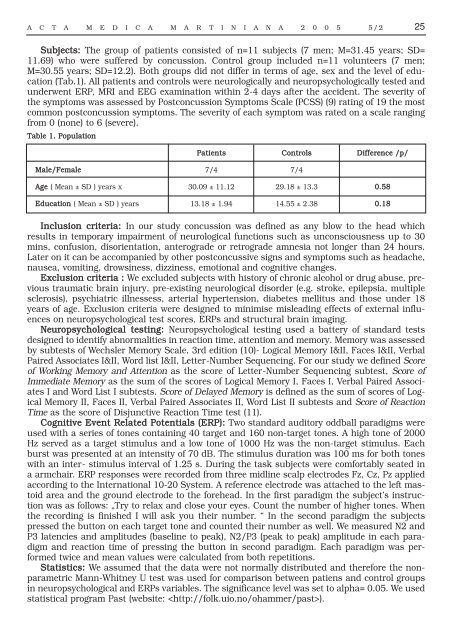MAKETA 5/2 po
MAKETA 5/2 po
MAKETA 5/2 po
Create successful ePaper yourself
Turn your PDF publications into a flip-book with our unique Google optimized e-Paper software.
A C T A M E D I C A M A R T I N I A N A 2 0 0 5 5/2 25<br />
Subjects: The group of patients consisted of n=11 subjects (7 men; M=31.45 years; SD=<br />
11.69) who were suffered by concussion. Control group included n=11 volunteers (7 men;<br />
M=30.55 years; SD=12.2). Both groups did not differ in terms of age, sex and the level of education<br />
(Tab.1). All patients and controls were neurologically and neuropsychologically tested and<br />
underwent ERP, MRI and EEG examination within 2-4 days after the accident. The severity of<br />
the symptoms was assessed by Postconcussion Symptoms Scale (PCSS) (9) rating of 19 the most<br />
common <strong>po</strong>stconcussion symptoms. The severity of each symptom was rated on a scale ranging<br />
from 0 (none) to 6 (severe).<br />
Table 1. Population<br />
Patients<br />
Controls<br />
Difference /p/<br />
Male/Female<br />
7/4<br />
7/4<br />
Age ( Mean ± SD ) years x<br />
30.09 ± 11.12<br />
29.18 ± 13.3<br />
0.58<br />
Education ( Mean ± SD ) years<br />
13.18 ± 1.94<br />
14.55 ± 2.38<br />
0.18<br />
Inclusion criteria: In our study concussion was defined as any blow to the head which<br />
results in tem<strong>po</strong>rary impairment of neurological functions such as unconsciousness up to 30<br />
mins, confusion, disorientation, anterograde or retrograde amnesia not longer than 24 hours.<br />
Later on it can be accompanied by other <strong>po</strong>stconcussive signs and symptoms such as headache,<br />
nausea, vomiting, drowsiness, dizziness, emotional and cognitive changes.<br />
Exclusion criteria : We excluded subjects with history of chronic alcohol or drug abuse, previous<br />
traumatic brain injury, pre-existing neurological disorder (e.g. stroke, epilepsia, multiple<br />
sclerosis), psychiatric illnessess, arterial hypertension, diabetes mellitus and those under 18<br />
years of age. Exclusion criteria were designed to minimise misleading effects of external influences<br />
on neuropsychological test scores, ERPs and structural brain imaging.<br />
Neuropsychological testing: Neuropsychological testing used a battery of standard tests<br />
designed to identify abnormalities in reaction time, attention and memory. Memory was assessed<br />
by subtests of Wechsler Memory Scale, 3rd edition (10)- Logical Memory I&II, Faces I&II, Verbal<br />
Paired Associates I&II, Word list I&II, Letter-Number Sequencing. For our study we defined Score<br />
of Working Memory and Attention as the score of Letter-Number Sequencing subtest, Score of<br />
Immediate Memory as the sum of the scores of Logical Memory I, Faces I, Verbal Paired Associates<br />
I and Word List I subtests. Score of Delayed Memory is defined as the sum of scores of Logical<br />
Memory II, Faces II, Verbal Paired Associates II, Word List II subtests and Score of Reaction<br />
Time as the score of Disjunctive Reaction Time test (11).<br />
Cognitive Event Related Potentials (ERP): Two standard auditory oddball paradigms were<br />
used with a series of tones containing 40 target and 160 non-target tones. A high tone of 2000<br />
Hz served as a target stimulus and a low tone of 1000 Hz was the non-target stimulus. Each<br />
burst was presented at an intensity of 70 dB. The stimulus duration was 100 ms for both tones<br />
with an inter- stimulus interval of 1.25 s. During the task subjects were comfortably seated in<br />
a armchair. ERP res<strong>po</strong>nses were recorded from three midline scalp electrodes Fz, Cz, Pz applied<br />
according to the International 10-20 System. A reference electrode was attached to the left mastoid<br />
area and the ground electrode to the forehead. In the first paradigm the subject’s instruction<br />
was as follows: „Try to relax and close your eyes. Count the number of higher tones. When<br />
the recording is finished I will ask you their number. “ In the second paradigm the subjects<br />
pressed the button on each target tone and counted their number as well. We measured N2 and<br />
P3 latencies and amplitudes (baseline to peak), N2/P3 (peak to peak) amplitude in each paradigm<br />
and reaction time of pressing the button in second paradigm. Each paradigm was performed<br />
twice and mean values were calculated from both repetitions.<br />
Statistics: We assumed that the data were not normally distributed and therefore the nonparametric<br />
Mann-Whitney U test was used for comparison between patiens and control groups<br />
in neuropsychological and ERPs variables. The significance level was set to alpha= 0.05. We used<br />
statistical program Past (website: ).

















